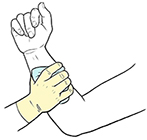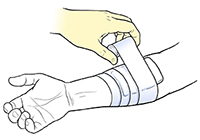A
B
C
D
E
F
G
H
I
J
K
L
M
N
O
P
Q
R
S
T
U
V
W
X
Y
Z
Click a letter to see a list of conditions beginning with that letter.
Click 'Topic Index' to return to the index for the current topic.
Click 'Library Index' to return to the listing of all topics.
First Aid: Cuts and Scrapes
A break in the skin is an open door, inviting dirt and germs to enter your body and cause infection.
Step 1. Control bleeding

Step 2. Clean and cover
-
Wash the scrape or cut with soap and water to kill germs and remove dirt and foreign objects.
-
Apply a topical antibiotic to minor cuts and scrapes that don't need medical attention (see below).
-
Cover the wound with a clean gauze dressing to reduce the risk of infection and further injury. Keep the dressing in place with a gauze or cloth bandage.
-
Don't tie or tape the bandage too tight.

When to call the healthcare provider
Call the healthcare provider or get medical care right away if any of the following is true:
-
The wound covers a large area or is deep.
-
The injury is on the face or any other area where scarring is a concern.
-
The person needs protection against tetanus. This is a disease caused by bacteria that may enter any break in the skin and bring on a life-threatening illness called lockjaw. A tetanus booster shot (injection) may be needed if it's been more than 5 years since the last tetanus vaccine.
Call 911
Call 911 if the injured person has any of the following:
Online Medical Reviewer:
Eric Perez MD
Online Medical Reviewer:
Paula Goode RN BSN MSN
Online Medical Reviewer:
Tara Novick BSN MSN
Date Last Reviewed:
3/1/2022
© 2000-2025 The StayWell Company, LLC. All rights reserved. This information is not intended as a substitute for professional medical care. Always follow your healthcare professional's instructions.